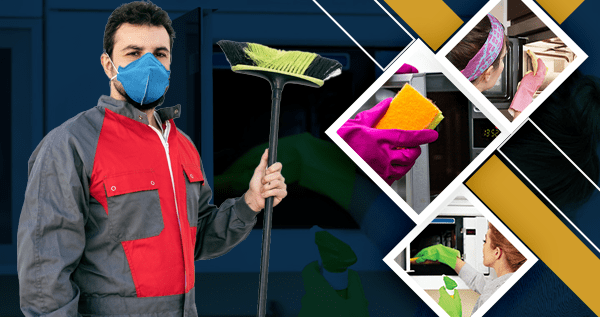Creating a Safe and Sanitized Environment: Commercial Building Cleaning Tips
A safe and sanitized environment is crucial for the success of any commercial building. Whether it’s an office, retail store, or healthcare facility, maintaining clean and hygienic spaces is essential for the well-being of employees, customers, and visitors. In today’s world, with the ongoing COVID-19 pandemic, the importance of proper commercial cleaning has become even more evident. In this article, we will discuss some valuable tips and strategies to create a safe and sanitized environment in commercial buildings.
The Importance of Professional Commercial Cleaning
Before we dive into the cleaning tips, it’s important to highlight the significance of professional commercial cleaning services. While regular cleaning done by in-house staff is essential, hiring a reputable commercial cleaning company, such as Crystal Facilities Management, can make a significant difference.
Professional cleaners have the necessary expertise, experience, and equipment to tackle even the most challenging cleaning tasks. They are well-versed in the latest cleaning protocols, ensuring that all areas of the building are thoroughly cleaned and sanitized. Moreover, partnering with a commercial cleaning company saves time and allows employees to focus on their core responsibilities.
Create and Implement a Cleaning Plan
A well-thought-out cleaning plan is the foundation of a safe and sanitized environment. Start by assessing the specific cleaning needs of your commercial building. Consider the size of the space, the footfall, and the nature of the business conducted in the building. Based on this evaluation, determine the frequency and extent of cleaning required for different areas.
Divide the building into zones and assign specific cleaning tasks to each area. For example, high-traffic areas like entrances, lobbies, and elevators may require more frequent cleaning compared to less frequently used spaces. Common areas, such as breakrooms and shared bathrooms, should be thoroughly cleaned and disinfected multiple times a day.
Document the cleaning plan and ensure that it is readily accessible to the cleaning staff. Clearly outline the tasks to be performed in each area, along with the recommended cleaning products and procedures. Regularly review and update the plan as needed to adapt to changing circumstances.
Invest in High-Quality Cleaning Equipment and Products
Cleaning is only as effective as the tools and products used. To achieve optimum results, invest in high-quality cleaning equipment, such as vacuum cleaners, mop buckets, microfiber cloths, and floor scrubbers. These tools not only enhance cleaning efficiency but also contribute to better indoor air quality.
Additionally, choose cleaning products that are safe, effective, and environmentally friendly. Using non-toxic cleaning agents minimizes the exposure to harmful chemicals and reduces the risk of allergic reactions. Look for cleaning products that are approved by relevant authorities and meet industry standards.
Implement Proper Waste Management
Proper waste management is an important aspect of maintaining a safe and sanitized environment. Make sure to have designated waste bins in strategic locations throughout the building. These bins should be easily accessible, well-labeled, and regularly emptied.
Implement a recycling program wherever possible to minimize the environmental impact of the waste generated. Educate employees and occupants about the importance of segregating waste into appropriate categories. Consider partnering with local recycling agencies to ensure that the recyclable materials are appropriately processed.
Train Cleaning Staff to Follow Best Practices
The cleaning staff plays a pivotal role in maintaining a safe and sanitized environment. It is crucial to train them in following best practices and adhering to the cleaning plan. Provide comprehensive training sessions on various cleaning techniques, proper handling of equipment and chemicals, and safety protocols.
Emphasize the importance of personal protective equipment (PPE) and provide the necessary gear, including gloves, masks, and aprons. Regularly update the cleaning staff with the latest information on cleaning protocols, especially during times of public health crises.
Focus on High-Touch Points
High-touch points in commercial buildings, such as door handles, elevator buttons, light switches, and handrails, are prone to accumulating germs and bacteria. Pay special attention to disinfecting these areas frequently, ideally several times a day.
Use EPA-approved disinfectants and follow the manufacturer’s instructions for proper usage. Allow enough contact time for the disinfectant to effectively kill the pathogens. Encourage employees and occupants to practice good hygiene by washing hands regularly and using hand sanitizers.
Regularly Deep Clean Carpets and Upholstery
Carpets and upholstery can harbor dirt, dust, allergens, and even bacteria if not cleaned regularly. Establish a routine deep-cleaning schedule for carpets and upholstery to maintain a fresh and healthy environment.
Consider hiring professional carpet cleaners, like Crystal Facilities Management, who have the expertise and equipment to deep clean carpets effectively. Regular deep cleaning not only improves the appearance of the commercial building but also removes hidden pollutants and extends the life of carpets and upholstery.
Monitor and Evaluate Cleaning Processes
Regular monitoring and evaluation of the cleaning processes are essential to ensure that the desired standards of cleanliness and sanitation are consistently met. Use quality control checklists to assess the cleanliness of different areas in the building.
Implement feedback mechanisms, such as suggestion boxes or online surveys, to gather input from employees and occupants. Utilize this feedback to identify areas for improvement and make necessary adjustments to the cleaning plan. Conduct periodic audits to ensure compliance with cleaning standards.
Conclusion
Creating a safe and sanitized environment in commercial buildings is of utmost importance, particularly in the midst of the ongoing COVID-19 pandemic. By implementing a well-structured cleaning plan, utilizing high-quality equipment and products, properly managing waste, and training the cleaning staff, you can ensure a clean and hygienic setting for employees, customers, and visitors.
Regularly focusing on high-touch points and deep cleaning carpets and upholstery, along with continuous monitoring and evaluation, will lead to a consistently safe and sanitized commercial building. Remember, for all your professional commercial cleaning needs, you can rely on Crystal Facilities Management to deliver exceptional services.













